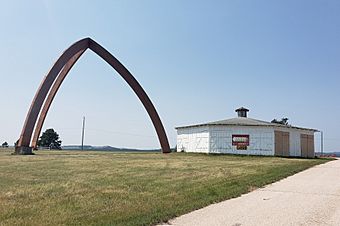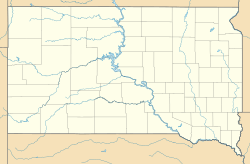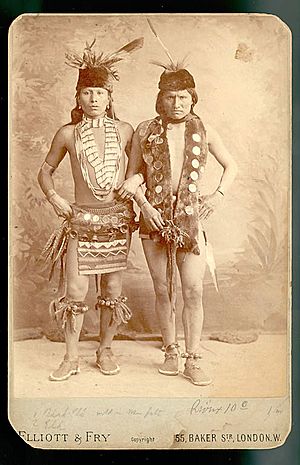Sitting Bull Crystal Cavern Dance Pavilion facts for kids
Quick facts for kids |
|
|
Sitting Bull Crystal Cavern Dance Pavilion
|
|

The pavilion in 2021, with arch sculpture in foreground
|
|
| Location | U.S. Highway 16 |
|---|---|
| Nearest city | Rockerville, South Dakota |
| Area | less than one acre |
| Built | 1934 |
| Built by | Duhamel, Alex, Bud and Peter |
| Architectural style | Polygonal |
| NRHP reference No. | 95001475 |
| Added to NRHP | December 14, 1995 |
The Sitting Bull Crystal Cavern Dance Pavilion is a special old building near Rockerville, South Dakota. It was built in 1934. This place used to host the Duhamel Sioux Indian Pageant. This pageant was a show of Lakota traditions and dances. It was created by a famous Lakota leader named Black Elk in 1927.
The pageant was very popular from the 1930s until 1957. It helped tourists visiting the Black Hills and Mount Rushmore learn about Lakota culture. Black Elk wanted to share Lakota traditions in a real and respectful way. The pavilion is now listed on the National Register of Historic Places. This means it's an important historical site because of its cultural meaning and its connection to Black Elk.
Contents
The Story of the Dance Pavilion
Who Started the Lakota Pageant?
The Duhamel Sioux Indian Pageant was started around 1927 by Black Elk. He was a respected Lakota spiritual leader and community elder. This was the first public Native American dance show in the United States. Before this, most shows featuring Native Americans were created by non-Native "Wild West shows." Black Elk himself had traveled the world with Buffalo Bill's show in the late 1800s.
Black Elk wanted to keep Lakota culture alive. He also wanted to show non-Native visitors that the Lakota people were not "savages." He wanted them to see the beauty and respect in Lakota traditions.
Why Was This Location Chosen?
Black Elk was good friends with the Duhamel family from Rapid City. At first, the pageant was held at their general store. Alex Duhamel, the father, had moved to Rapid City in 1879. He traded with the local Lakota people and built strong friendships.
In 1929, the Duhamels bought the land where the Sitting Bull Crystal Caverns are. This land was right off South Dakota Highway 16. Tourists going to Mount Rushmore would drive right past it. The caverns became a popular tourist stop. Black Elk thought the road to the caverns was a perfect spot for the pageant's theater. Also, the caverns and the Rockerville Gulch area are very special and sacred to the Lakota people.
Building the Pavilion and Village
Alex Duhamel and his sons, Pete and Bud, helped build the pavilion. It was finished in 1934. They also built a small building shaped like a tipi outside the hall. This was where tickets were sold.
Next to the pavilion, they set up a model of a traditional Lakota village. It was called the Sioux Indian Village. Visitors could walk through this village. They could meet the performers from the show. Tribe members also sold their handmade items here. The attraction was named after Sitting Bull, a famous Lakota chief. One of the pageant performers was his nephew, John Sitting Bull.
What Happened During the Shows?
The shows took place twice a day during the summer months. This happened from 1934 to 1957. The performers stayed at a private camp behind the village. Alex and Peter Duhamel would lead them to the pavilion. Peter also translated and hosted the events.
Black Elk himself led many traditional Lakota ceremonies. These included healing rituals, holy pipe ceremonies, and mourning rituals. Dances like the Ghost Dance and Sun Dance were performed. There was also a Rabbit Dance, where visitors could join in. Sometimes, new ceremonies were added to attract more people. For example, an advertisement from 1940 mentioned a "dog feed" feast and a "horse dance." At the end of each show, a hat was passed around for donations. All the money went directly to the performers.
Changes in Laws and Traveling Shows
For many years, some Native American rituals and dances were not allowed by U.S. law. This was especially true after the Wounded Knee Massacre in 1890. So, when the Sioux Falls Dance Pageant started in 1927, some of its ceremonies were technically illegal. However, the ban was lifted later in 1934. An advertisement from the 1940s said the pageant had "special permission" from the government to continue.
The dancers also performed shows in other cities. They performed in Rapid City, sometimes outside the Duhamels' store. They also traveled to places like Omaha, Nebraska and Cedar Falls, Iowa. In Cedar Falls, Chief Red Bear joined the group. He and Black Elk even spoke about their experiences at the Wounded Knee Massacre.
Why the Pageant Ended
Interest in the pageant started to fade after World War II began. Alex and Peter Duhamel both passed away in 1941. Black Elk died in 1950. Bud Duhamel took over running the shows. Black Elk had retired from performing before he died. It became hard for the Duhamels to find Lakota people willing to perform after he left. The Duhamel Sioux Indian Pageant finally closed in 1957.
Bud Duhamel continued to run the Sitting Bull Crystal Caverns until 1998. The caverns were open for public tours until 2015. Today, the dance pavilion is used for storage. On December 14, 1995, the pavilion was added to the National Register of Historic Places. This recognized its important cultural and religious history, its link to Lakota history, and its connection to Black Elk.
What Does the Pavilion Look Like?
The pavilion is a building with eight sides, shaped like an octagon. It's built from white wooden boards and sits on a concrete base. All eight sides have large double doors for people to enter. The roof is shaped like a cone and is supported by a central column. A small, eight-sided tower called a cupola sits on top of the roof. Both the roof and the cupola are covered with asphalt shingles.
Inside, there are five large paintings called murals. These murals show famous places nearby. They were created by a Sicangu Lakota artist named Godfrey Broken Rope. The inside of the pavilion has not changed since 1957. That's when the audience seats were removed. The small tipi-shaped building that sold tickets was taken down in the early 1990s.
The Arches Sculpture
South of the pavilion, there's a tall sculpture made from three wooden arches. It's about 60 feet (18 meters) tall. These arches were originally meant for a bridge in 1967. But they fell off a truck on the way to the building site. Even though they seemed okay, the South Dakota Department of Transportation decided not to use them.
These arches were planned for a "Rushmore Memorial Arch Park" at a different spot. This park was meant to honor five key people involved in creating Mount Rushmore. The arches were put up and could be seen into the 1980s, but the memorial park was never finished. The sculpture, known as "The Arches," was moved to its current spot in the 1990s.
Images for kids






